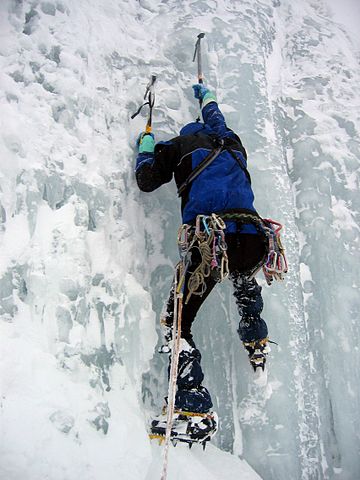*Crampons get dull with mixed climbing

Your crampons will become dull with use. Varied terrain wears hard on crampons. Ice climbing tends to wear the front points, and mixed climbs are particularly hard on crampons as they tend to dull quickly early in the season when mountains still have a light covering of snow and ice.
Here are a few tips on how to keep your crampons clean and sharp for your icy adventure.
Climbing in the Alps is hard on crampons

Crampons must be sharpened often, as mountaineers often travel up slopes where the mountain is covered with ice and snow in parts and is bare rock on others, with the climber transitioning from one surface to the other. Those who often climb snowy mountains, such as the Alps in Europe, the High Rockies or Alaskan ranges, the Himalayas or the Canadian Rockies, find their crampons become dull quite quickly.
Before embarking on an expedition, you will need to ensure that your crampons are sharp. You should also take along with you a small file with which to sharpen them while you are in the mountains.
Crampon points must be sharp

While you are climbing, you need to check your crampons regularly. Sharpen them whenever they get dull – they work optimally when they are sharp. It is imperative that your crampons are sharpened at least once a season, particularly at the start of the ice season
The front points of your crampons need to be very sharp for ice climbing and on mixed climbing routes. If the points are really sharp, it causes less damage to the ice. The bottom parts need not be as sharp as their purpose is mainly for foot traction and gripping on ice terrain with a lower angle.
Clean ’em up

Your crampons need to be clean before you begin to sharpen them. Crampons tend to get really grubby during ice climbing, and the hinges get particularly affected. Begin by rinsing them and brushing them off in water with detergent. They must be properly dry before you sharpen them. Do not risk rust by storing them wet.
The tools you need
A hand file is sufficient for the job. The most efficient kind is a flat mill bastard file. It has a flat face and a mid-grade roughness on the cutting teeth. A small vise or clamp will make the job easier. Without one of these, you’ll need to hold them while wearing rugged gloves to prevent you from injuring your hands
Once you have cleaned your crampons

File the crampon point. The idea is to get the point to the standard it was when new. Do this by pushing towards the point and not scraping the file to and fro across the blade. Try to keep a straight line from the tip to the frame. File the side points. These do not have to be blade sharp, but the front points must be as sharp as they can be. The best thing is that you sharpen the horizontal front points from the top angle. Sharpen the vertical points from each side. An electric grinder is not the best idea, as the metal could get overheated thus weakening the crampon by causing it to lose temper. If you decide to use an electric grinder do so with caution and go slowly with light contact.
When you feel your crampons are sharp enough, rinse and wash them again. Once they are free of fillings you can check that there are no burrs on the edges. Straighten any bent points and inspect for fatigue cracks. Ensure that the sidewalls are not too thin from repeated sharpening. Check the attachment rivets, straps and plastic cages to ensure they are secure. Do these checks regularly.
If you have any comments then please drop us a message on our Outdoor Revival Facebook page
If you have a good story to tell or blog let us know about it on our FB page, we’re also happy for article or review submissions, we’d love to hear from you.
We live in a beautiful world, get out there and enjoy it. Outdoor Revival – Reconnecting us all with the Outdoors.
